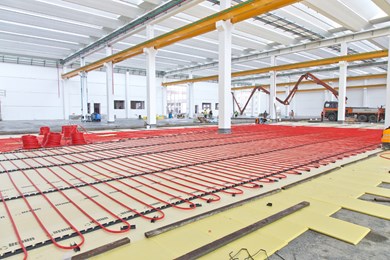Ideal for large expanses subject to heavy loads
Industrial radiant flooring
Recodi has 20 years of experience in the laying of radiant flooring.
Radiant panels are the ideal system for low-temperature heating.
The pipework/tubing is laid on the ground onto insulating material and subsequently encased in the concert. The principle is based on the circulation of water at low temperatures (up to 40°C) in a closed circuit, which covers a very high radiant surface.
The pipework/tubing is laid on the ground onto insulating material and subsequently encased in the concert. The principle is based on the circulation of water at low temperatures (up to 40°C) in a closed circuit, which covers a very high radiant surface.
Thermal wellbeing
To ensure, in any given space, conditions of suitable thermal wellbeing it is important to maintain slightly warmer areas on floor level and slightly colder at ceiling level. The systems that are best-placed to achieve these conditions are radiant heating systems, for the following reasons:
- the specific position on the floor of the radiant panels meets the prerequisites to ensure that the ideal conditions are attained thanks to the diffusion of the heat from the low level to the upper level
- the fact that these systems transfer heat above all through radiation avoids the formation of warm convective air currents at ceiling level and cold currents at floor level.
Air quality
Panel heating is able to avoid two problems that typically affect heating elements:
- the combustion of atmospheric dust, which can give rise to a sense of dryness and an irritated throat
- the high level of circulating dust that (especially in spaces that are not very clean) can be a cause of allergies and breathing diff
Hygienic conditions
Panel systems have a positive influence on the maintenance of good environmental hygiene conditions for the following reasons:
- they avoid the formation of damp zones on the floor, thereby preventing the creation of a suitable environment for mites and bacteria
- they avoid the growth of mould and associated bacterial fauna on walls next to warm walls.
Environmental impact
In new constructions and on renovation projects where the floors are being overhauled, panel systems are the options with the lowest environmental impact because:
- they do not impose any aesthetic limitations. The fact that the panels are concealed under the screed is very important, above all when there is a requirement to fit air-conditioning systems in historically or architecturally significant buildings, where the presence of heating elements can compromise the balance of the original forms
- they put no limits on design schemes, thus allowing the most rational use of the available space
- they do not contribute to the degradation of plasterwork, wooden floors and frames, because they do not stain the walls with carbon black, nor do they allow for damp to function at floor level; moreover, they limit indoor condensation because they increase the temperature of the walls close to the floor slabs equipped with panels.
The heat that can be used at low temperatures
Thanks to their high heat-dissipating surface, panel-based systems can provide heat with low temperatures of the thermovector fluid. This property makes their use advisable in combination with sources of heat that have a higher (thermodynamic or economic) yield when they must work at low temperature levels, as in the case of:
- heat pumps
- condensing boilers
- solar panels
- heat-recovery systems
- remote-heating systems, with heating costs linked (directly or indirectly) to the return temperature of the primary fluid.
Energy saving
Compared to traditional heating systems, panel-based systems allow for appreciable energy savings, essentially for two reasons:
- after a certain period of radiation, the radiant-panel system reaches a point of maximum efficiency at which the volume to be heated is close to the ideal curve of thermal wellbeing. The maintenance of this condition requires a minimal waste of energy, in contrast to what happens in systems with heating elements, in which the radiation always occurs at high temperatures. This affords average savings of between 5 and 10%
- the lower thermal gradient between floor and ceiling delivers energy savings that increase in proportion to the height of the space.
On average, panel-based systems enable variable energy savings of between 10 and 15% with respect to traditional systems. There are other elements that influence energy saving, albeit to a lesser extent that the aforementioned factors:
- the use of low temperatures that reduces waste along the pipework
- the non-overheating of the walls behind the radiators
- the lack of convection of warm air on glazed surfaces.

